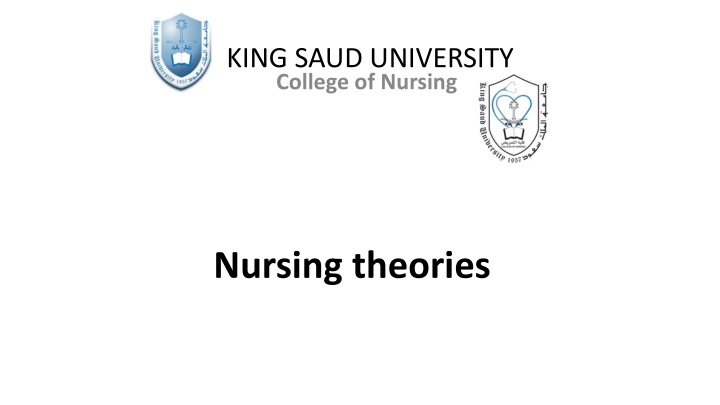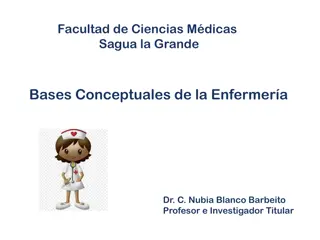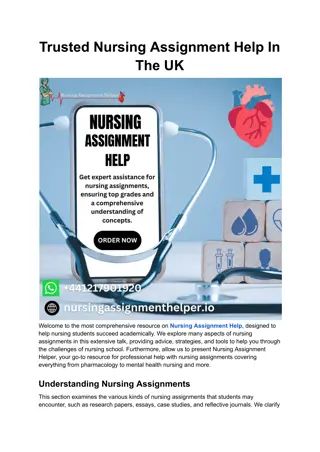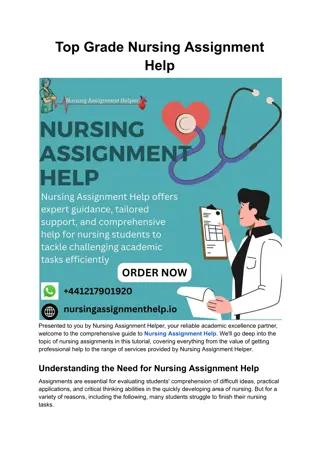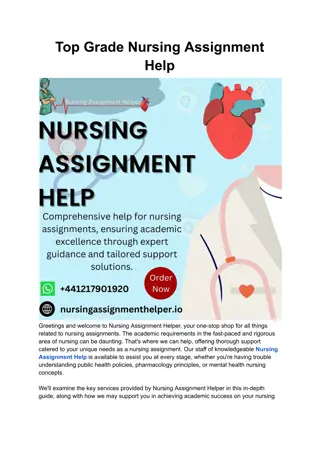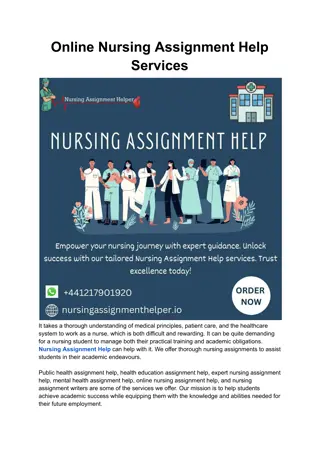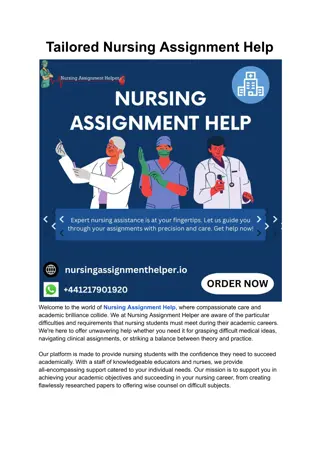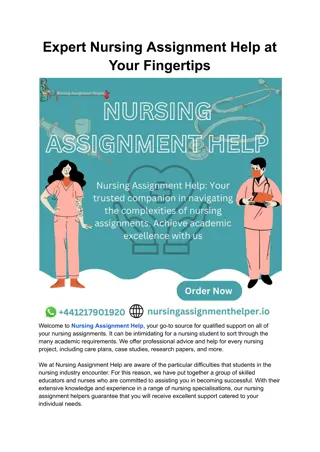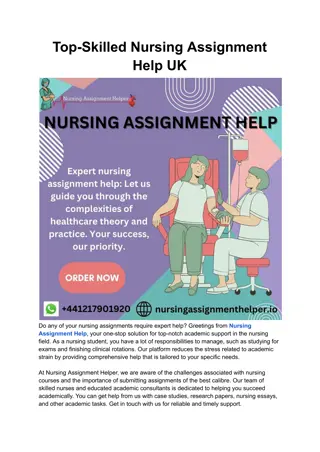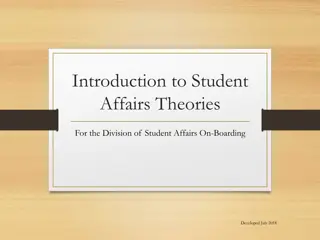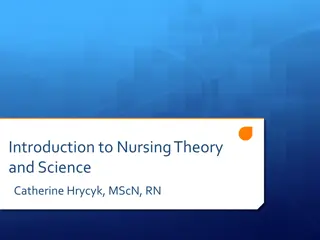Nursing theories
Delve into the hierarchical structure of nursing knowledge, exploring concepts, propositions, and theories within the nursing profession. Understand the significance of nursing theory in shaping practice, research, and professional development, with a focus on key theories like the Self-Care Deficit Theory and the Roy Adaptation Model. Gain insights into the relationships between concepts and propositions, theory development, and the role of paradigms and metaparadigms in nursing.
Download Presentation

Please find below an Image/Link to download the presentation.
The content on the website is provided AS IS for your information and personal use only. It may not be sold, licensed, or shared on other websites without obtaining consent from the author.If you encounter any issues during the download, it is possible that the publisher has removed the file from their server.
You are allowed to download the files provided on this website for personal or commercial use, subject to the condition that they are used lawfully. All files are the property of their respective owners.
The content on the website is provided AS IS for your information and personal use only. It may not be sold, licensed, or shared on other websites without obtaining consent from the author.
E N D
Presentation Transcript
KING SAUD UNIVERSITY College of Nursing Nursing theories
Objectives Describe concept, proposition, theory, paradigm, and metaparadigm. Explain the relationships of concepts and propositions to theory. Describe the link between nursing theory and the continuing development of the nursing profession. Explain the relationship between nursing practice, nursing theory, and nursing research. Apply the principles of selected nursing theories, such as the Self- Care Deficit Theory of Nursing, and the Roy Adaptation Model, to nursing practice.
KNOWLEDGE DEVELOPMENT IN NURSING The knowledge in a particular profession can be arranged in a hierarchical structure that ranges from abstract to concrete. Theories Represent the most concrete component of a profession. Several theories that share a common view of the world can be grouped together to form a paradigm.
Paradigm Is a particular viewpoint or perspective about the phenomena of concern to nursing Several paradigms grouped together is called met paradigm Meta paradigm Is the most abstract component of knowledge and which can consist of more than one paradigm. Each discipline has a defined metaparadigm A metaparadigm is the unifying force in a discipline that names the phenomena of concern to that discipline.
Nursing Theory Provides a perspective from which we can describe: what is nursing, who of nursing (who is the client), when nursing is needed, and the boundaries and goals of nursing s therapeutic Interventions. The professionalization of nursing has been brought about through the development and use of nursing theory. In this class, we will discuss the meaning of nursing theory and its relevance to professional nursing.
Issues related to the purpose, use, and diversity of nursing theories are discussed. Then, abroad overview of selected nursing theories are provided. Where, major ideas of these nursing theories are explained and examples of their use in nursing situations are provided.
Components of Theories The basic elements of a nursing theory are concepts and propositions. Concept: Is the basic building block of a theory. Is a vehicle of thought, mental image , name or labels of perceptions about ideas, phenomena, or things of the world. Concepts help us to name things and occurrences in the world around us and assist us in communicating with each other about the world.
Two types of concepts Concrete and Abstract Concrete concepts Have observable fact that can be perceived through the senses and explained (e. g. brain, chair, pen, key, hat, etc.) A concept has a clear mental image about an object or situation. Abstract concept: Complex, cannot be directly observed but must be inferred by certain concrete or less abstract indicators Intelligence, health, self concept, etc.)
Concepts (cont.) Concepts are socially constructed label that may represent more than a single phenomenon. For example: When you hear the word chair The mental image that probably comes to mind is an item of furniture used for sitting. The word chair could represent many different kinds of furniture for sitting, such as a desk chair, a high chair, or an school chair. Further, the word chair could also represent the leader of a committee or the head of a corporation. Therefore, the meaning of the word chair depends on the context in which it is used.
Major concepts in nursing are: Environment Person Health Nursing
Propositions Describe the relationships between concepts Represent how concepts affect each other. Example: people seem to be happier in the springtime. This proposition establishes a relationship between the concept of happiness and the time of the year. An other example: multiple and rapid losses predispose one to feelings of helplessness. linking the concept of helplessness and the concept of loss
Theory A theory is a set of concepts and propositions that provide an orderly way to view phenomena. The purpose of the theory, may be description, explanation, and prediction of phenomenon. A theory not only helps us to organize our thoughts and ideas, but it may also help direct us in what to do and when and how to do it.
In addition to using theories specifically constructed to describe, explain, and predict the phenomena of concern to nursing, the nursing profession has long used theories from nursing other disciplines. For example, non-nursing theories such as: Maslow s Hierarchy of Basic Human Needs Erikson s Theory of Human Development, and Selye s General Adaptation Syndrome to name few.
Why do we have nursing theories? Before 1950s, nursing knowledge was extremely limited and almost entirely task oriented. The explosion of knowledge, created the need to systematically organize the tremendous volume of new information being generated.
The categorization of knowledge and the analysis of client care situations help us communicate in coherent and meaningful ways. Theories provide us with frameworks for decision making in practice. Theories help nurses establish professional autonomy and, ultimately, control of certain aspects of practice. Theories help develop the knowledge base to respond to changes in societal needs.
Relationship between Nursing Practice, Theory, and Research Nursing research is the systematic application of formalized methods for generating valid and dependable information about the phenomena of concern to the discipline of nursing. The relationship between nursing practice, theory, and research is depicted in following figure Nursing practice is the focal point of the relationship between practice, theory, and research.
It provides the raw material for the ideas that are systematically developed and organized in the form of nursing theory. The ideas proposed by nursing theory must be tested and validated through nursing research. In turn, new knowledge that results from nursing research is used to transform and inform nursing practice. Alternatively, nursing practice generates questions that serve as the basis for nursing
Scope of Theory Although theories address relatively specific and concrete phenomena, they vary in scope. Scope refers to the relative level of substantive specificity of a theory and the concreteness of its concepts and propositions.
There are three different categories relate to the scope of theories: Grand theories Middle-range theories Micro-range theories.
Grand Theory Composed of concepts representing global and extremely complex phenomena. It is the broadest in scope, represents the most abstract level of development, and addresses the broad phenomena of concern to nursing. An example of a grand theory is Orem s Self-Care Deficit Theory of Nursing.
Scope of Theory Micro-range theory A micro-range theory is the most concrete and narrow in scope. Explains a specific phenomenon of concern to the profession For example: the effect of social supports on grieving and would establish nursing care guidelines to address the problem.
Micro-range theory A micro-range theory is the most concrete and narrow in scope. Explains a specific phenomenon of concern to the profession For example: the effect of social supports on grieving and would establish nursing care guidelines to address the problem.
Some of the more contemporary theories in nursing are creating new views of: Person, Environment, Health, and Nursing. What are your beliefs about the nature of the person? Do you view the person as a holistic being or parts that make up a whole? Is your concept of environment centered more on external or internal conditions? Can the person be considered in isolation of the environment? How do you define health? Is illness the opposite of health? What is the purpose of nursing? How does nursing accomplish its goals?
Orems Self Care Model Proposes that self care involves activities that people initiate and perform on their own. The model focuses on the person s role in self-health care People generally know how to take care of themselves (self care).
According to each persons ability to meet self-care needs, the nurse provides: Wholly compensatory (when the person totally dependent on others) Partially compensatory (when the person partially dependent on others) Supportive-educative care (when the person need some type of education).
Roys Adaptation Model Human are considered as biopyschosocial beings in constant interaction with the changing environment. A person must adapt to a variety of stimuli. There are three types of stimuli Focal: Immediately confront a person in a given situation such as loss of loved one Contextual: Background stimuli that include the person s sex, developmental stage, coping mechanisms, and surrounding environment
Residual: Beliefs, attitudes, and traits. Nursing is needed when unusual stress occur or coping mechanisms is weak. Nurses help people adapt in four different modes: Physiological needs, Self-concept, Role function, and Interdependence The focus is the total being, not as in medicine where the focus is on disease process.
Evidenced Based Practice (EBP) Is the integration of clinical expertise, patient values, and the best research evidence into the decision making process for patient care. How long we should put a thermometer in patient mouth to obtain body temperature (1,3,5 minutes). Too much time cost more and less comfortable to the patient, less time may lead to inaccurate measurement
Think about it: A hospital of 1000 bed we need to obtain temp. three time a day (then we need 1000X 3= 3000 times) If we measure the temp in 1, 3, and 5 minutes the time needed will be 3000, 9000, 15000 minutes, means 50, 150, 250 hours, this equals to 4, 12, 20 nurses working full time The question then, if measuring temp. in 3 minutes produce same results as 5 minutes, then we are wasting the work of 8 nurses. This beside the discomfort to patients.
Implementing New Practice Finding Best Practices (EBP) Location in literature Online database (e. g.: CINAH, MedLine, PubMed Evidence-based practice centers (e. g.: Cochrane Collaboration ) Journals (e. g.: Evidence-Based Nursing)
Three steps in managerial support Establishing a new culture Creating capacity for organizational change Sustaining change through revision of system s infrastructure
Five Steps to Ensuring Practice is Evidence-Based Develop a researchable practice question Design and implement an evidence search Retrieve and appraise evidence Integrate clinical evidence in order to implement an evidence-based decision Evaluate clinical practice and EBP process outcomes
Barriers to EBP Implementation Lack of time, organizational support, perceived power to effect change, and literature Uncertain of personnel s ability to use research Critical colleagues Cost to implement Interdisciplinary support
